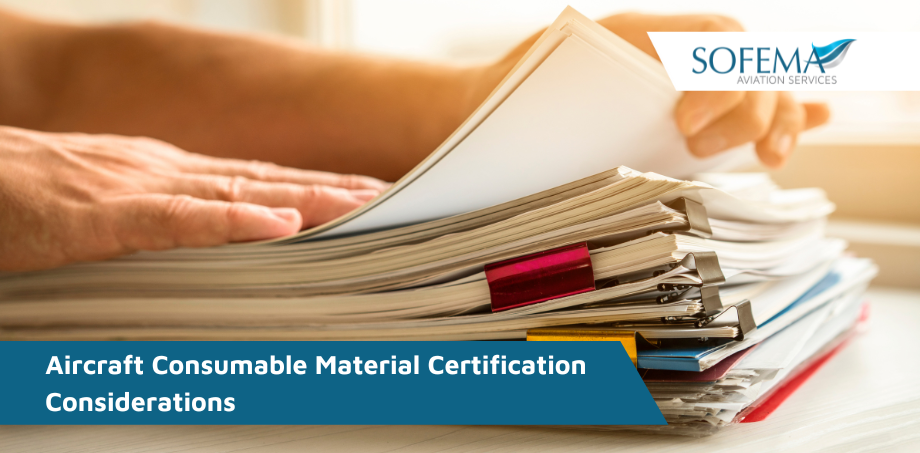Sofema Aviation Services (SAS) www.sassofia.com looks at the process for managing Aircraft Consumable Material.
Introduction
- Materials that are intended to be installed in type-certificated aircraft, engines, or propellers may not be produced unless they are produced according to FAA (or EASA) regulations;
- The typical method for approving original aviation materials is through the type and production certification (TC/PC) process;
- A typical method for approving replacement aviation materials is through the parts manufacturing approval (PMA) process (European – see European Parts Approval (EPA)).
Note 1: Materials that meet government or established industry specifications are considered standards and may not need separate FAA approval.
Note 2: Aftermarket materials, used to replenish or replace consumable materials in an aircraft, that are not standard articles, would typically be approved under a Parts Manufacturer Approval (PMA).
Consumable Materials can be divided into two major categories.
- The first category is items not part of the aircraft, engine, or propeller.
o This class includes items like solvents, cleaning agents, emery paper, masking tape, and cutting oils.
o In many cases, the material may be identified by the design approval holder of the aircraft, engine, or propeller.
- The second category of consumable materials consists of those materials that become part of the aircraft, engine, or propeller.
o Examples of these items can include hydraulic fluids, lubricating oils, greases, sealants, adhesives, room-temperature vulcanizing silicone compounds, paints, lock-wire, and high-temperature tapes.
Note: These materials are all consumable items that become part of the aircraft, engine, or propeller, and they were part of the type-certificated product when the FAA approved the product.
FAA Production Rules for Materials
In 2009, the FAA’s regulations concerning aircraft parts approval were changed. The new regulations explain that an article that is reasonably likely to be installed on a type-certificated product (aircraft, propeller or engine) may not be produced unless it fits into one of six categories:
o It is produced under a type certificate;
o It is produced under an FAA production approval;
o It is a standard part (such as a nut or bolt) manufactured in compliance with a government or established industry specification;
o It is a commercial part as defined in § 21.1 of this part;
o It is produced by an owner or operator for maintaining or altering that owner or operator’s product; or
o It is fabricated by an appropriately rated certificate holder with a quality system, and then consumed in a repair or alteration.
These six categories tell us that articles must be either FAA approved, or fit into one of the narrowly-defined categories of articles that do not need to be FAA-approved.
The definition of the term “article” is stated in the FAA’s regulations: (“Article means a material, part, component, process, or appliance.”)
How Can You Legally Produce an Aviation Material?
o The production certificate holder, of course, can approve materials that are found within the scope of the production certificate holder’s design and production approval.
o The appropriate FAA approval for materials that are not produced by the production certificate holder is usually going to be a PMA.
Note 1: Although the term PMA stands for Parts Manufacturer Approval, the PMA rule has always been available as a source of approval for materials (The PMA regulations repeatedly use the term “article” as the base unit on which a PMA is issued -this is the term that is defined to include materials.
Note 2: PMA Material is test to at least the same standard (or higher) than required for certification.
Exceptions to the Rules
- Materials that are not reasonably likely to be installed on a type certificated product (e.g. materials designed and intended for non-aviation uses);
- Materials that are not installed (e.g. cleaners and solvents that are used to clean aircraft parts, but that will not be introduced into the type certificated product);
- Materials that are produced in compliance with a government or established industry specification (i.e. standard materials; e.g. Materials produced to AMS,ASTM or MIL standards);
- Materials that are produced by a Production Certificate (PC) holder;
- Materials that are produced by a Technical Standard Order Authorization (TSOA)holder;
- Materials whose production method is approved by the FAA under an alternate approval method
o When approved by the FAA under an alternate approval method,” the FAA retains the authority to decide that it can declare anything as “approved” based on any metric that the FAA selects.
Conclusion
- Consumable materials are articles under the FAA’s regulatory definitions.
- Consumable materials that are created with the reasonable expectation that they may be introduced into a type-certificated product (for example to replace consumable materials that were consumed or otherwise lost from the type-certificated product), are required to be produced under FAA approval or under an explicit exception to the requirements for FAA approval.
- Forms of production approval that may apply include a PMA or production certificate (including production by a supplier with direct ship approval from the production approval holder).
Failure to comply with the FAA regulations may subject the fabricator (and others) to liability under the FAA regulations.
Next Steps
Follow this link to our Library to find & Download related documents for Free.
Sofema Aviation Services (www.sassofia.com) and Sofema Online (www.sofemaonline.com) provides EASA compliant Regulatory & Vocational Training. For additional details, please visit our websites or email team@sassofia.com
Tags:
Aircraft Consumable Material, EASA, European Parts Approval (EPA), FAA, Parts Manufacturer Approval, SAS blogs, Technical Standard Order Authorization (TSOA)




